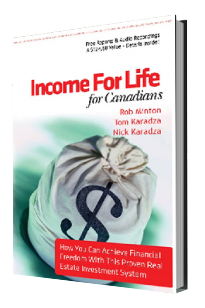History of Economics:
To Better Understand Real Estate You Need To Know Today's Money System

The Importance of the History of Economics
History of Economics: To Better Understand Real Estate You Need To Know Today's Money System
To really understand the economy, and the history of economics, you need to spend time learning about monetary
policy, otherwise, everything ends up being “noise” with no real value to you.
Over the last few years, we’ve felt very comfortable with our investing decisions because we now understand how the current money game is played.
And we thought it would be a good idea to share some of what we’ve learned. Let’s dive in: Canada didn’t always use the “Canadian Dollar” as it’s currency. In fact, as recently as the early 1900’s the Canadian Imperial Bank of Commerce (CIBC) and the Royal Bank of Canada (RBC) were issuing their own receipts on deposits that were used as this country’s currency.
Let’s go back in time and reveal how the monetary system, the “money game”, has evolved.
1871 to 1914 The Classical Gold Standard
From approximately 1870 to 1913 most of the industrialized word was using the “classical gold standard.”
This meant that most of the world’s currencies were pegged to a specific value of gold. For example, one dinar may have been worth 1/16 ounce of gold or one dollar may have been worth 1/8 ounce of gold.
Because each currency had a set value they were, in effect, also pegged in value to each other.
This made it very easy for businesses to trade with each other and more importantly it made it extremely easy to project and plan into the future.
For example, if a business was going to open up a new location in another country they knew exactly how much it would cost. They didn’t have to worry about that country’s currency losing value and destroying the value of the business. Everyone always knew what the exchange rate between currencies would be.
This also meant that during this time there was no inflation.
There were definitely ups and downs in different asset classes but the gold standard always made sure things levelled off over short periods of time.
This concept confuses most economists but here’s how this worked:
1. Countries that boomed imported goods.
2. They paid for these goods with gold so gold left the country.
3. This deflated the money supply and slowed the boom (slowed the economy).
4. This then made demand decline for goods and prices fell.
5. With lower prices the country was then attractive to foreign investment and gold flowed back into the country expanding the economy.
Many economist (professionals in the history of economics) argue that this system couldn’t work today because there isn’t enough gold to go around.
From all of our research, a simple percentage gold allocation would get everyone back to honest money again. There’s no need for every dollar to be backed by an entire ounce of gold, a small fraction would do the trick.
1913 to 1944 U.S. Federal Reserve
In 1907 there was a large banking and stock market panic in the U.S.
A group of the richest men in the world convinced the government to approve the creation of the Federal Reserve.
It was, and still remains, accountable to no one, and has no audit and no direct government supervision.
It’s a completely private bank that happens to use the word “Federal” to make it seem like a government entity. Amazing eh?
Since the Fed began, all the currency of the U.S.A. was borrowed into existence from the Fed, and it’s all owed back to the Fed with interest.
Loans are made to the U.S. government, which begins using the money and depositing it into banks.
Banks are then allowed to use “fractional reserve banking”, which means that they are allowed to lend out more money than they have on deposit at a set ratio. If the Fed sets the ratio at 9:1, then the bank can lend out $9,000 for every $1,000 it has in deposits.
They literally “make up” the extra $8,000 out of thin air and lend it out, making interest on money which they never had.
This seems like a good deal huh? Which is why we want to start the bank of Rock Star but that’s a discussion for another day :-) During this time, “income tax” was first created as well.
Canada took a little longer to follow this system, but around 1934 (in the history of economics), as best as our research can tell, the Bank of Canada came into existence and we’ve been using the same system here in Canada since that time.
History of Economics: 1944 to 1971 The Bretton Woods Act
The U.S. got itself out of the Great Depression by President Roosevelt devaluing the dollar by almost 50%. This created new demand for U.S. goods from overseas. At the same time, there was a huge influx of gold into the U.S. because of a new price setting of $35 and because of Europe’s fear of Adolf Hitler.
The U.S. became one of the world’s largest holders of gold and remains so today.
In 1944 it was decided, with the Bretton Woods Act, that all countries would peg their currency to the U.S. dollar and the U.S. would make their currency redeemable in gold at a rate of $35 per ounce.
This existed until 1971, when Richard Nixon was forced to close the “gold exchange window.” The U.S. announced to the world it would no longer exchange its currency for gold and in that instant all currencies around the world, including the Canadian Dollar, became free-floating “fiat” currencies backed by nothing but U.S. paper.
Basically, at this point in history, the U.S. declared bankruptcy but no one dared call it that.
History of Economics: 1971 to Present Print, Print Away
After 1971 there was nothing keeping the U.S. currency “honest.” They didn’t have to acquire more gold to print currency, so they began printing away.
Politicians could begin promising all sorts of new programs without worrying how to pay for it, and deficit spending became the new way of life in the U.S. and around the world.
With no check and balance to spending, it’s proven too tempting for government’s to spend irresponsibly and it’s become the public’s expectation that the government should have enough money for every program it wishes.
So, although gold remains a barbaric relic, it does serve its purpose of acting as a store of value and keeping people “honest” and not spending money that they don’t have.
We now live in an environment where debt levels must increase to maintain our standard of living, strange but true. If there’s enough interest we can elaborate on this topic further, just send a note to Suggestions@ RockStarBrokerage.com that you find this valuable and we’ll continue this little history of economics historical money chat!
Return from the History of Economics to the Residential Real Estate buying guide by clicking here...
Some Cool Free Stuff...
Step 1:
|
Grab a free digital copy of our real estate investing book, Income For Life For Canadians, right here. This book has been downloaded over 22,597 times and has helped hundreds of investors kick-start their investing with simple and straight forward strategies that you can implement right here in Canada. |
 |
|
You'll also receive our weekly [Your Life. Your Terms.] email newsletter with the latest investing updates and videos. |
Step 2:
|
Free Weekly Investing Videos & Articles: Get the latest updates and join the over 10,000 other Canadians enjoying the weekly [Your Life. Your Terms.] email newsletter. The email is sent out each Thursday. And as a little bonus we'll give a FREE digital copy of the book, Income For Life For Canadians, too! |
Your Life. Your Terms.
Step 3:
|
Free LIVE Investing Class: Do you live in the Greater Toronto or Golden Horseshoe Area? Come out to our next introductory "Investing in Nice Homes in Nice Areas" Real Estate Class. |
 |
|
It's 90-minutes and you'll learn a ton - promise!Thousands of investors have now joined us for this class and the feedback has always been amazing. |



